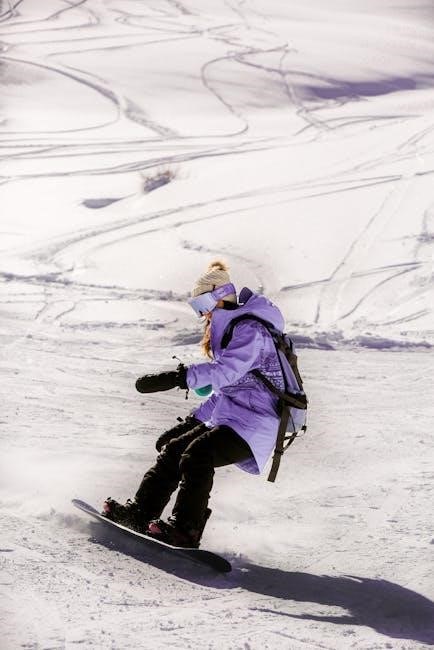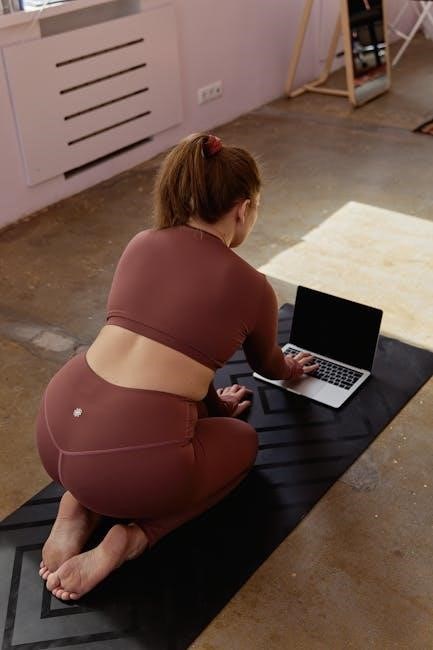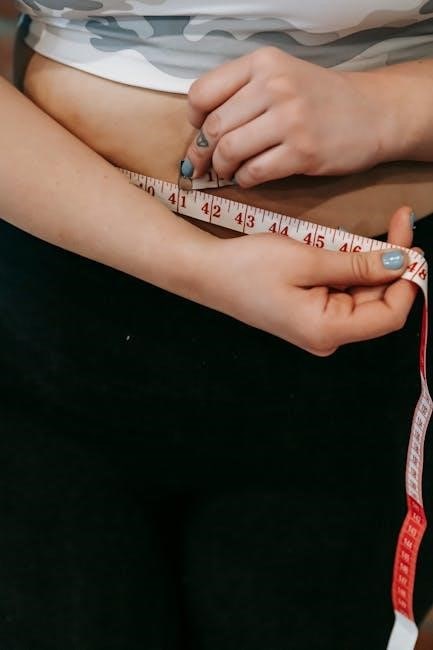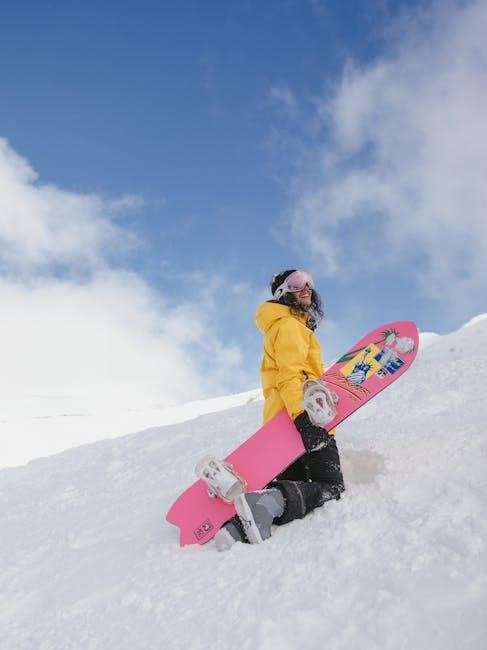Women’s Snowboard Size Guide
Finding the right snowboard size is crucial for performance and enjoyment. This guide helps women navigate snowboard sizing based on weight, height, and ability. Use charts as a starting point to find the right snowboard length for your needs.

Choosing the correct snowboard size can be a complex process, but it’s essential for maximizing your experience on the slopes. For women, snowboard sizing involves considering several important factors beyond just height. This guide provides a comprehensive overview to help you find the perfect fit. We aim to simplify the process, ensuring you select a snowboard that matches your skill level, riding style, and physical attributes.
Understanding snowboard sizing is crucial whether you’re a beginner or an expert. A well-sized board enhances control, stability, and overall performance. Our guide incorporates various elements, including weight, height, and boot size, to provide tailored recommendations. We also delve into how different snowboard styles influence sizing decisions, ensuring you’re equipped with the knowledge to make an informed choice. With the right snowboard size, you’ll be able to progress faster and enjoy every run to the fullest. Let’s explore the key factors that determine the ideal snowboard size for women.
Factors Influencing Snowboard Size

Several key factors influence the ideal snowboard size for women. Weight is a primary consideration, as it directly impacts how the board flexes and responds. Height also plays a significant role, determining the overall length needed for stability and control. A rider’s ability level is another crucial aspect. Beginners often benefit from shorter boards, which are easier to maneuver, while advanced riders may prefer longer boards for increased stability at higher speeds.
Snowboard style and terrain preferences further influence sizing decisions. Freestyle riders typically opt for shorter boards that enhance agility in park settings. All-mountain riders often choose mid-length boards that offer versatility across various terrains. Boot size is also vital, ensuring compatibility with the board’s width to prevent toe or heel drag. By considering these factors holistically, you can select a snowboard that optimizes your performance and enjoyment on the mountain. Understanding how these elements interact will guide you toward the perfect fit for your individual needs and riding style.
Weight as a Primary Factor
Weight serves as a primary determinant in selecting the appropriate snowboard size. A rider’s weight directly influences how the snowboard flexes and responds to input. If a snowboard is too soft for a rider’s weight, it may feel unstable and difficult to control, especially at higher speeds or on challenging terrain. Conversely, if a snowboard is too stiff, it may be challenging to initiate turns and maintain control, particularly for lighter riders or beginners.
When determining the ideal snowboard size based on weight, consult size charts provided by manufacturers as a starting point. These charts typically offer a range of recommended board lengths based on weight ranges. It’s essential to consider that these charts are estimates. Adjustments may be necessary based on other factors such as height, ability level, and riding style. Accurate weight consideration ensures optimal board performance and a more enjoyable snowboarding experience.
Height and Its Relation to Snowboard Length
Height plays a significant role in determining the appropriate snowboard length. While weight is a primary factor, height provides additional context for selecting the right size. Generally, taller riders require longer snowboards to maintain stability and control. A longer board offers a greater edge length, providing increased stability at higher speeds and in varied terrain. Conversely, shorter riders may find it easier to maneuver and control a shorter snowboard.
The traditional method of sizing a snowboard involves standing the board vertically and ensuring it reaches somewhere between your chin and nose. However, this is a general guideline, and adjustments may be necessary based on other factors.
It’s important to consider the relationship between height and weight when selecting a snowboard. If you fall within a weight range that corresponds to multiple board lengths, your height can help you narrow down the options. If you are taller for your weight, opting for a slightly longer board within the recommended range may be beneficial.
Ability Level and Snowboard Size
A rider’s ability level significantly influences the ideal snowboard size. Beginners often benefit from shorter boards, which are easier to control and maneuver. A shorter board allows for quicker turns and requires less effort to initiate, making it more forgiving for those still learning the basics. As riders progress, they may find that a longer board offers greater stability and control at higher speeds.
Intermediate riders can typically handle a board that is closer to the middle of the recommended size range for their height and weight. This provides a balance of maneuverability and stability, allowing them to explore different terrains and riding styles. Advanced riders often prefer longer boards, especially for all-mountain or freeride riding. A longer board provides increased edge hold and stability for carving and navigating challenging conditions.
Ultimately, the best snowboard size for your ability level depends on your personal preferences and riding goals. Consider how you plan to use the board and choose a size that will help you progress and enjoy your time on the mountain.
Beginner Snowboard Sizes
For women new to snowboarding, selecting the right size board is crucial for a positive learning experience. Generally, beginners should opt for a shorter snowboard within the recommended size range based on their weight and height. A shorter board is easier to control, making it more forgiving and less tiring for those still developing their skills. This enhanced maneuverability allows beginners to learn turning and stopping techniques more efficiently.

A shorter board also reduces the chances of catching an edge, a common issue for beginners that can lead to falls. When choosing a beginner snowboard size, consider a board that reaches somewhere between your chin and nose when stood on its end.
Remember to factor in your weight, as a lighter rider may benefit from an even shorter board. As you progress and gain confidence, you can transition to a longer board that offers more stability at higher speeds. However, starting with a shorter, more manageable board will set you up for success and make learning snowboarding more enjoyable.

Intermediate to Advanced Snowboard Sizes
As women progress from beginner to intermediate or advanced snowboarders, their board size preferences typically shift towards longer lengths. Intermediate riders often seek increased stability at higher speeds and improved floatation in powder, both of which are enhanced by a longer snowboard. An advanced rider may choose a board that reaches their nose or even slightly above, depending on their preferred riding style and terrain.
Longer snowboards provide more edge hold, allowing for more aggressive carving and confident turns on various snow conditions. Furthermore, a longer board offers better float in deep snow, making it ideal for riders who enjoy venturing off-piste. It is essential to consider your weight and riding style when selecting an intermediate to advanced snowboard size.
If you primarily ride groomed runs and enjoy carving, a slightly longer board within the recommended range can enhance your performance. Conversely, if you prefer freestyle riding or spending time in the park, a slightly shorter board might be more suitable for enhanced maneuverability. Experimenting with different lengths within the appropriate range can help you find the perfect board for your individual needs and preferences.

Snowboard Style and Terrain
The type of snowboarding you enjoy and the terrain you ride significantly influence the ideal snowboard size. Different styles, such as freestyle, all-mountain, and freeride, demand specific board characteristics to optimize performance. Freestyle riders, who spend time in terrain parks and performing tricks, often prefer shorter boards for increased maneuverability and easier spinning. A shorter length allows for quicker rotations and more playful handling on rails and jumps.
All-mountain riders, who tackle a variety of terrain, typically opt for a mid-length board that balances stability and agility. This versatile option performs well on groomed runs, in powder, and in the park, making it suitable for diverse riding conditions. The recommended length for all-mountain boards usually falls within the middle of the suggested size range based on height and weight.
Freeride snowboarders, who seek out challenging terrain and deep powder, often choose longer boards for enhanced floatation and stability at high speeds. A longer board allows riders to stay on top of the snow in deep conditions and maintain control when navigating steep slopes. The perfect board will allow you to enjoy the mountain to the fullest.

Freestyle Snowboard Sizing
Freestyle snowboards are designed for riders who prioritize park performance, tricks, and playful riding. When selecting a freestyle snowboard, size is a crucial factor that directly impacts maneuverability and control. Generally, freestyle snowboards are shorter than all-mountain or freeride boards, allowing for easier spins, quicker rotations, and enhanced responsiveness in the terrain park.
For women who focus on freestyle riding, choosing a snowboard that falls on the shorter end of their recommended size range is typically ideal. A shorter board makes it easier to perform tricks, such as ollies, nollies, and rail slides, due to its reduced swing weight. This allows for quicker adjustments and more precise movements while executing freestyle maneuvers.
However, it’s essential to consider personal preferences and riding style when determining the exact size. Some freestyle riders may prefer a slightly longer board for added stability on larger jumps or when riding outside the park. Experimenting with different lengths can help you find the perfect balance between maneuverability and stability for your freestyle endeavors. Shorter boards offer more control on rails.

All-Mountain Snowboard Sizing
All-mountain snowboards are designed to perform well in a variety of conditions and terrains, making them a versatile choice for riders who enjoy exploring the entire mountain. When it comes to sizing an all-mountain snowboard for women, finding the right balance between stability, control, and maneuverability is key.
Generally, all-mountain snowboards fall within a moderate length range, typically aligning with the rider’s recommended size based on weight and height. This allows for sufficient edge hold and stability on groomed runs while still providing enough responsiveness for navigating trees, powder, and variable snow conditions.
For women seeking an all-mountain snowboard, it’s often recommended to choose a board that is closer to the middle or slightly longer end of their recommended size range. A slightly longer board offers increased stability at higher speeds and better floatation in deeper snow, enhancing the overall riding experience across different terrains.
However, personal preferences and riding style should also be taken into account. Riders who prioritize carving and stability may opt for a longer board, while those who prefer more maneuverability in tight spots might choose a slightly shorter length. Ultimately, the ideal size will depend on individual preferences and the type of terrain most frequently ridden.

Snowboard Width and Boot Size

Matching your snowboard width to your boot size is crucial for optimal performance and control. If your boots overhang too much, you risk toe or heel drag, which can cause you to lose control and potentially crash. Conversely, if your boots are too small for the board, you won’t be able to effectively engage the edges.
Women generally have smaller feet than men, so it’s especially important to pay attention to snowboard width. Most women’s snowboards are designed with a narrower waist width to accommodate smaller boot sizes. Use a snowboard width and boot size chart to find the right match.
To determine the correct snowboard width, start by measuring your snowboard boots. Then, compare your boot size to the recommended waist width range for snowboards. Ensure your boots don’t extend excessively over the edges of the board. A slight overhang is acceptable, but too much will hinder your riding.
If you’re between sizes, it’s generally better to err on the side of a slightly wider board. This will provide more stability and prevent toe or heel drag. However, avoid going too wide, as it can make it difficult to initiate turns. Consider consulting with a snowboard expert for personalized advice.
Women’s Snowboard Size Chart (Example)
A women’s snowboard size chart serves as a valuable tool to pinpoint the ideal board length based on your weight and height. Remember that this is just an example, and specific brand charts may vary slightly, so always consult the manufacturer’s recommendations. This chart assumes an all-mountain riding style.
For instance, a woman weighing between 100-120 lbs and standing 5’2″ to 5’4″ might find a snowboard in the 142-146 cm range suitable. Someone weighing 120-140 lbs with a height of 5’4″ to 5’6″ could opt for a 146-150 cm board. These are general guidelines, and personal preferences play a key role.
Consider that if you’re a beginner, it’s often advisable to choose a board on the shorter end of the recommended range for easier control. Conversely, advanced riders or those who prefer riding powder might prefer a longer board for added stability and floatation.
Always cross-reference your weight and height to find the overlapping range. This will provide a more accurate starting point. Don’t hesitate to seek advice from experienced snowboarders or shop staff to ensure you select the perfect size for your individual needs and riding style.
Understanding Binding Size Charts for Women
Selecting the correct snowboard binding size is as critical as choosing the right board. Women’s binding size charts typically correlate binding size (S, M, L) with women’s boot sizes. Ensuring a proper fit is essential for optimal control and responsiveness on the slopes.
For example, a small (S) binding might accommodate women’s boot sizes 5-6, while a medium (M) binding could fit sizes 6.5-8.5. A large (L) binding often fits sizes 9-11. These ranges can vary slightly between brands, so always consult the specific chart provided by the binding manufacturer.
When your boot size falls between two binding sizes, it’s generally recommended to size up. This ensures your boot fits comfortably and securely within the binding without excessive toe or heel overhang. Overhang can impact board control and increase the risk of toe or heel drag.
Consider the type of riding you’ll be doing. Freestyle riders might prefer a snug fit for enhanced board feel, while all-mountain riders may prioritize comfort. Proper binding fit is vital for transmitting energy efficiently from your body to the snowboard, ultimately enhancing your riding experience.
If possible, try on your snowboard boots with the bindings before purchasing to guarantee a secure and comfortable fit. Seek advice from knowledgeable shop staff to confirm you’ve chosen the appropriate binding size for your specific boot.

